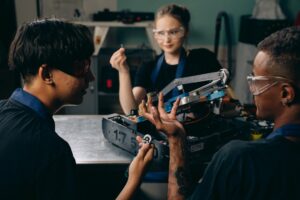Manufacturing automation may appear to be a recent notion to some people, but it dates back several decades. However, the difference between then and now is introducing new technologies that help industries gain more control over their operations.
The value of factory automation is well over $200 billion. In addition to establishing operational control, automation of production methods, master schedules, and advancements, manufacturing automation increases production capacity while simultaneously keeping costs down.
Manufacturing automation uses technology, such as robotic equipment and software to automate the whole manufacturing process from start to end. Manufacturing automation is in several categories.
Types of Manufacturing Automation
The field of manufacturing automation is quite broad. Therefore, a wide range of automated technology solutions exists for dealing with different issues. Here are a few illustrations:
1. Fixed Manufacturing Automation
Fixed automation refers to setting automation to create a specific item on a single machine. Investing in fixed automation is an expensive procedure that has a high barrier to entry. Because of its high cost and high barrier to entry, it is well suited for lathe industries and large manufacturing companies.
Hard automation, which is the other name for fixed automation, is a collection of many diverse sequences and industrial methods put together in one place. It may be challenging to change production procedures after equipment installation, especially when considering the significant initial investment necessary for its design and technological development. The most common fixed automation examples include:
- Assembly lines
- Conveyor systems for moving materials
- Processes used in the manufacture of chemicals
2. Programmable Automation
Programmable automation, as the name indicates, is a production process controlled by a program. An application program is a series of directives that the system reads, understands, and then executes.
The ability to be flexible is a fundamental component of programmable automation. You can configure it to handle a vast number of product combinations and sequences. Additionally, you have the option of entering a new program to manufacture more goods. The use of programmable automation in automated batch production is a suitable fit for this application.
The following are some instances of programmable automation:
- PLCs (programmable logic controllers) are a type of logic controller that is easy to program.
- Machine tools that are numerically controlled
- Robots in the manufacturing industry
3. Flexible Automation
In some ways, flexible automation and programmable automation are similar in terms of functionality. The architecture of flexible automation enables it to respond quickly to changes in production circumstances, such as fluctuations in product quantities, by adjusting its operations.
The programming of the systems that control the equipment is the responsibility of the personnel. Human Machine Interfaces (HMIs) are an option that they can choose to employ. In this design, centralized system software monitors the functioning of the production and material handling processes.
Furthermore, it is an excellent choice if you wish to create several different product categories simultaneously. Batch production is most suited to flexible automation because of its flexibility.
The following are some applications of flexible automation:
- Robotics
- Material handling systems
- Assembly lines
What is The Role of Robotics in Manufacturing Automation?
Robots are highly prized for various reasons. They are dependable, consistent, accurate, repeatable, and resistant to dangerous environmental conditions.
In contrast to humans, robots cannot adapt to unforeseen situations or enhance performance based on past experiences, as people do. Some of the most popular robotic applications in manufacturing automation are as follows:
- Assembly
As the expense of physical labor in assembly processes continues to climb, the use of robots in assembly is on the increase. Furthermore, robots use programs, which make it simple to automate assembly methods. Before performing any actions, robots must first comprehend the design of the product.
- Processing operations
Another area of manufacturing automation in which robots might be beneficial is processing materials and products. Spraying and painting, spot welding, and arc welding are only a few of the most common types of fabrication and processing activities. For car bodywork, such as frame and panel construction, spot welding is a standard application in the automotive industry.
Spraying and painting are two processes in which a robot manipulates a spray-painting gun across the surface of a coated object to apply paint. In arc welding, a robot moves a welding rod over the seams of the product in a continuous process. Routing, polishing, grinding, and deburring are just a few other processing techniques that a robot can do.
- Material handling
The use of robots in manufacturing automation includes the transportation of items from one location to another. Several of the material handling operations carried out by the robots is straightforward in their execution. Picking and placing applications, for example, are generally specific.
On the other hand, the automated machines also perform other sophisticated applications, such as palletizing in patterns that they must compute. One example is the loading and unloading of objects with the assistance of a gripper connected to the mechanical arm.
Inspection
Machine inspection is yet another domain of manufacturing whereby robots are increasingly helpful. In a standard inspection task, the robot attaches a sensor to the work component and determines whether or not the item meets the quality standards.
What are the Advantages of Automated Manufacturing?
Manufacturing automation is rapidly becoming a need rather than an option in manufacturing operations. The utilization of robots and artificial intelligence provides you with a significant competitive advantage over your competition.
The following are the benefits of incorporating automation into your manufacturing operations.
- Reduced operating expenses
Although it requires a significant upfront cost, automation gives exceptional long-term value for money. A single robot can accomplish the tasks of three to five, or perhaps more, human workers.
- Enhanced safety at the workplace
Several manufacturing processes need employees to operate in potentially hazardous situations. However, the introduction of automation of the production floor is tremendously changing the position. The machines take over the dangerous operations while human workers relocate to safer activities.
- Increase in productivity
Apart from operating unsupervised round the clock, robots can also keep the same pace throughout. As a result, your manufacturing process runs continuously and more effectively, which increases production.
- Improved product quality
Overall, robots are more accurate than humans are in the performance of industrial jobs. Furthermore, they retain the same level of manufacturing quality throughout the process. Better uniformity and consistency will result in a decreased percentage of defects in the final product.
Wrapping up
The efficiency of automation by using robotics and AI is changing the way of doing things in the manufacturing sector. Automation makes everything easier, increases production, improves product quality, makes the workplace safer for both machines and humans, and cuts costs.
With new entrants in the market, such as the collaborative robots, which have smaller footprints, you can also count saving floor space as another advantage of automation.






